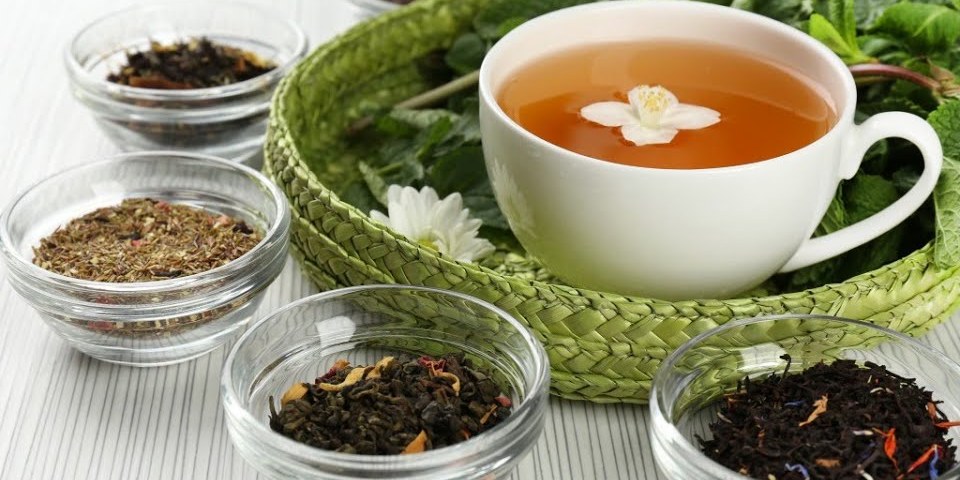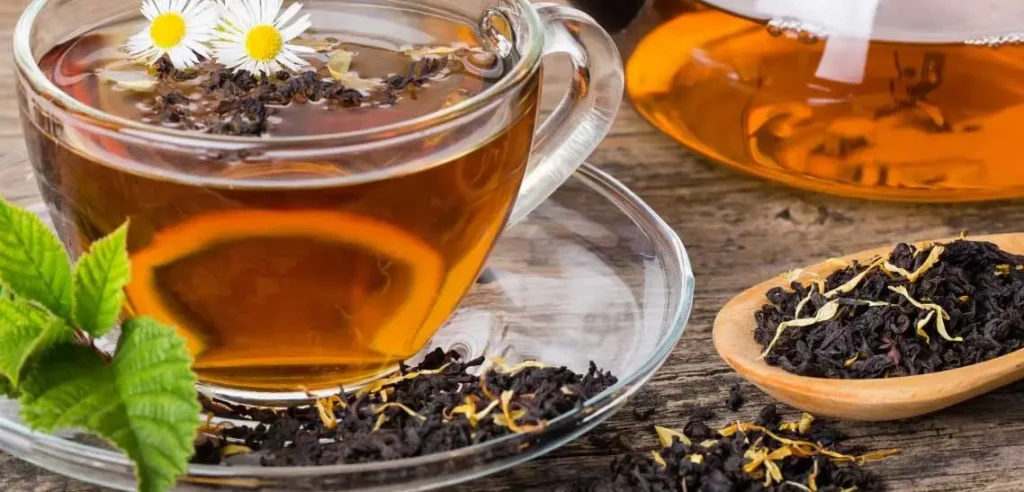Despite the fact that only an infusion of tea leaves (camellia sinensis) can be considered real varieties of tea, most people are used to calling all other herbal drinks created by brewing various plants with this word.
In this article, we have tried to create the most complete “guide” to the most famous classic types of tea.
Tea varieties by type of plant
According to this parameter, tea is divided into two categories – actually from Camellia sinensis and from other plant components.
There are only 6 main varieties of tea that are made from the tea leaf: black, green, white, yellow, oolong and pu-erh. They differ from each other in the degree of fermentation and the method of processing, but the plant is always the same – the already mentioned Camellia sinensis, which is a bush or tree.
Black red)
Black tea is the most popular in our country and in the European part of the world. In China, it is known as red – the color of the infusion. This type of tea is produced by strong fermentation (oxidation). As a rule, it has a tart rich taste.
Green
Green tea undergoes minimal fermentation. This type of processing keeps the levels of antioxidants, vitamins and minerals high. The tea has a golden yellow infusion and a light and grassy taste. Most popular in Asia.
Varieties of white tea
Weakly fermented (almost not fermented) tea containing tips (tea buds). Especially popular in China, it is considered the most useful. White tea has a light yellow color and a delicate aroma.
Yellow
Weakly fermented tea from high quality raw materials. The degree of oxidation is between white and green. It is considered very rare and most often can only be purchased in China.
Son
A semi-fermented tea that occupies a middle position between black and green. According to the degree of oxidation, it is divided into highly fermented (closer to black tea) and low-fermented (closer to green) varieties. Oolongs give an infusion from light yellow to light brown, the taste is rich and bright.
Puerh
Post-fermented varieties of tea that “ripen” after normal fermentation in a natural (sheng pu-erh) or accelerated (shu pu-erh) way. The final fermentation takes place thanks to special microorganisms (aspergillus acidus). Dark pu-erhs become a red-brown infusion, sometimes with an earthy taste. Light pu-erhs give a different infusion – from yellow-green to light brown.
From other plants (tisanes)
Although real tea can only be called a drink based on a tea leaf, in global terminology this word combines a lot of drinks that are created by brewing herbal ingredients in hot water. It can be leaves, flowers, and even roots. Many tisanes are the national treasure of the countries in which they appeared.
Roybush
A traditional African drink, which is obtained from the stems, leaves and shoots of the linear aspalatus shrub. In appearance, the leaves of this plant look like small needles. A tea drink prepared on its basis does not contain caffeine and is considered beneficial even for children. It has a delicate sweet taste.
Mate
An ethnic variety of tea from Paraguay, it is created from the leaves of the Paraguayan holly. Very popular in South America, has a tonic effect, because it contains caffeine (mateine). It is traditionally drunk from a special dish made from dried gourds, using a metal straw. It has a light yellow color and a grassy aroma.
Karkade
A tea that is often called red because of the bright color of the infusion. It is prepared from hibiscus flowers, does not contain caffeine, but contains a lot of vitamin C. It can be consumed by children.
Anchan
Thai tea from the blue flowers of the clitoria trifoliate. Does not contain caffeine, is considered a health drink. Gives a bright blue exotic color of the infusion.
Ku Qiao
A Chinese drink made from Tatar buckwheat, it is also called buckwheat tea. It has an indirect relation to ordinary buckwheat, since it is prepared from the seeds of another plant related to ordinary buckwheat. Does not contain caffeine.
Herbal teas (herbal teas)
Most of the herbal drinks known to us can be classified as herbal teas – this is chamomile tea, and Ivan tea, and an infusion of thyme or oregano. Herbal tea can include both one component (mono tea) and several (herbal tea). A couple of decades ago, herbal tea could only be bought at a pharmacy or collected in the country, but today in any hypermarket there is a department with these drinks.
All varieties of tea, in turn, can be divided into five main categories:
- from inflorescences (chamomile, linden, lavender, pomegranate);
- from leaves (mint, lemon balm, thyme, raspberries, currants, strawberries, etc.);
- from roots (ginger, turmeric, dandelion, ginseng, licorice, etc.);
- from the bark (oak, buckthorn, willow, etc.);
- from seeds (fennel, anise, amaranth, etc.).
Fruit and berry teas
Fruit and berry teas are made from natural fruits. Most often they have a natural sourness or sweetness, but they are never cloying. Fruit teas are rich in vitamins and do not contain caffeine, which allows them to be drunk in the evening and given to children. They can also be consumed cold as a healthy alternative to carbonated drinks. Fruits and berries can be brewed both fresh and dried.

Varieties of tea according to the format of the tea leaf
The tea leaf after all kinds of sorting and processing may look different. There are several categories depending on its integrity and quality. Most countries adhere to the following classification:
- large-leaf – a variety of tea from whole leaves or leaves cut into large pieces;
- medium leaf (Broken, broken) – tea from chopped leaves;
- small-leaf (Fannings, cuttings) – tea from finely chopped leaves;
- tea dust (Dust) – tea from very small parts of the leaf, similar to dust;
- tips (T) – kidneys (tips) predominate in tea;
- peko (P) – tea from ordinary leaves;
- orange (O) – upper leaves;
- orange pekoe (OR) – a mixture of upper and ordinary leaves;
- granular (STS) – a leaf heavily crushed with a machine.
Type of tea according to shape
Powder
Powdered tea is similar in appearance to colored flour or powder. This type of tea includes classic matcha made from green tea, blue matcha based on clitoria trigemina, hojicha (ground roasted green tea), pink matcha, and traditional black tea in the form of powder. The drink should be brewed in a special way – beating with a whisk, cappuccinatore or using a blender.
Loose
It is the loose variety of tea that we buy most often. It exists in the form of individual leaves or their parts. Such tea is sold packaged in sealed packages or can be bought by weight. Loose tea should be brewed according to the classical instructions – in a teapot / French press / gaiwan, for a certain amount of time.
Connected
This form of tea was invented in China and is more of a decorative style. Bound tea is brewed in order to enjoy the beauty of leaves and flowers blooming in hot water and enter into a meditative contemplative state. Most often, they associate green or white tea by placing a flower of clover, chrysanthemum, rose, jasmine, etc. inside.
pressed
Pressed teas are solid briquettes or “pancakes” in which the leaves have been compressed under pressure into a specific firm shape. To brew such tea, you must first chip off the required amount of tea leaves from the bar. If it is pu-erh, it is recommended to use a special knife that helps to cope with dense “bricks”.
packaged
This category includes tea bags, pyramids, sticks and capsules. Such tea was considered less quality in the past, but these days it is gradually gaining more and more trust from customers thanks to new technologies that are used to produce it.
Extract teas
Tea in liquid form, ready to drink immediately after adding to water. Sold in small sachets-sticks and is a mixture of syrup with plant extract. Typically contains artificial additives to extend shelf life.
Lumpy
A rare type of tea, which is typical only for Chinese pu-erh. It is a cross between loose and pressed tea.
Types of tea by the presence of additives
Tea can be made completely without additives (monochai) or supplemented with a flavor composition of various components.
Flavored teas are created in two main ways – by adding natural ingredients (flowers, herbs, fruits) or by using flavors.
With natural additives
Natural additives can turn the most ordinary tea into a completely new drink:
- fruits and berries,
- flowers and herbs,
- spices,
- sweets (candied fruit, chocolate).
With flavors
Flavored tea is the choice of people who like an intense and full-bodied taste. Specialists from large chemical laboratories in Europe are working on the creation of high-quality and safe flavors.
mixed type
Very often, manufacturers use both methods to create a bright taste, using both natural additives and flavors.

Varieties of tea by origin (countries)
The taste of the finished drink, even within the same type of tea, varies greatly depending on the terroir, region and climate. Below is the top ten producing countries ( according to the British site ) and five more countries whose products are available to Russian buyers. Of course, in fact, this is not a complete catalog – this list includes only the most prominent participants in the tea market.
China grade tea
The birthplace of tea and one of the most advanced producing countries of this drink. China has always been the leader among suppliers – about 40% of the world market share, which is about 2.4 million tons of tea per year. It is mainly grown in the provinces of Yunnan, Guangdong and Zhejiang. Chinese tea is considered one of the best in the world, it is represented by all six varieties, including yellow tea, which is created only in China.
India
India produces 1.25 million tons of tea annually, which automatically puts this country in second place. The pace was set by the British in 1824 to compete with China. The idea paid off, and over the next 200 years, India really became a powerful rival to Chinese tea production, especially with regard to black tea. Two-thirds of production comes from four tea regions in northern India: Assam, Darjeeling, Duars and Sikkim. Another third is produced in Nilgiri and Kerala, located in southern India. Indian tea has been very popular in Russia since ancient times and inspires great confidence among customers.
Kenya
Tea was first brought to Kenya in 1903, and over the next 100 years, production here has gained enormous proportions. Today, Kenya annually supplies about 500,000 tons of tea to the world market and claims to be the leading producer on a par with China and India. Kenyan tea is grown in the highlands in the east and west of the Great Rift Valley, at an altitude of 1500 to 2000 m. On the Russian market, it is much less common than tea from the first two countries, although it is also considered to be of very high quality.
Sri Lanka
Sri Lanka produces just under 350,000 tons of tea per year (about 17% of the world’s harvest). It all started in 1867, when the British tried to create another competitor to China on the site of failed coffee plantations. Since then, the country has been producing some of the finest teas in the world that are unparalleled. They are grown mainly in 6 regions: Uva, Dambulla, Uda Pussellawa, Nuwara Eliya, Kandy and Ruhuna. At the same time, the height difference of tea plantations is very different, which provides a diverse palette of tastes.
Turkey
Turkey grows about 250,000 tons of tea annually, producing mostly black varieties, including black powdered tea. At the same time, a greater volume of production remains in the country.
Vietnam
Since the French introduced the tea leaf culture to the Vietnamese during their colonial rule, the country has risen to sixth in tea production. Today, Vietnam supplies about 240,000 tons of raw materials per year from plantations located mainly in Yen Bai Province in Northern Vietnam. The range includes several varieties of tea – green, black and white.
Indonesia
Indonesia produces about 144,000 tons of tea annually. For the first time, a tea bush from Indian Assam varieties was brought to this country in the 1700s by the Dutch East India Company. The right climate allowed the new culture to take root and become an important part of the Indonesian economy. Tea is grown on the islands of Java and Sumatra. In Java, the fragrant product of the highest quality is obtained in August and September. In Sumatra, you can harvest all year round. Many producers like to complement their blends with soft and delicate Indonesian teas.
Argentinean teas
Argentina produces just under 90,000 tons of tea per year. This is mainly black tea of Indian origin, as well as traditional Argentine mate. The classic tea variety began growing in Argentina in the 1920s, when the country’s government encouraged farmers to experiment with various new crops. Plantations are found in the provinces of Misiones, Corrientes, Formosa, Chaco and Tucumán.
Japan
Japan is a country where tea varieties are of great cultural importance. About 80,000 tons of this product are produced here annually (in the regions of Shizuoka, Kagoshima and Uji). The history of Japanese tea began many centuries ago, when Buddhist monks brought it to their homeland. Today, the Japanese specialize mainly in the production of green tea of all kinds. Sencha and matcha are the most popular export commodities, but most of the tea grown in Japan is actually consumed domestically.
Iranian tea variety
Iran supplies the world with just under 75,000 tons of tea per year. In this country, tea first appeared as a drink in the 15th century, thanks to trade along the famous Silk Road, and quickly became very popular. However, large-scale production began only in the 20th century, when the first mechanized tea factory was founded.
Taiwan
The history of tea here began in the 18th century, when Camellia sinensis trees were first brought to the region. Today, Taiwan is the world leader in the production of oolongs (about 20% of the total volume), and black, green and white teas are also grown here. There are plantations in almost all areas of the country, but Alishan, Taitung and Yu Shan are considered the most significant.
Nepal
Tea has been grown in Nepal for hundreds of years, but it is quite a rare and expensive product, since it is produced in very limited quantities. Nepalese tea is always hand-made (it is physically impossible to raise the equipment to a height of up to 2500 meters above sea level). In Russia, this tea is very rare.
Varieties of tea by value
The price is affected by many factors: the place where the tea grows (terroir), the time it is harvested (spring months or later), the type of raw material (buds, top leaves or ordinary), the method of collection (manual or machine), the aging time (young or mature) . There are three main categories here.
Premium grade tea
This brand of tea includes mainly perennial aged pu-erh, oolong and white tea. Less common are black (red), yellow and green. Premium tea is not easily accessible to the mass consumer, as it is produced in limited quantities from expensive and rare raw materials.
middle class tea
Quality tea available to most customers. It is produced in large quantities from good, but not unique raw materials.
Economy class tea
It is usually produced from the cheapest raw materials that remain after sorting more expensive varieties of tea.






